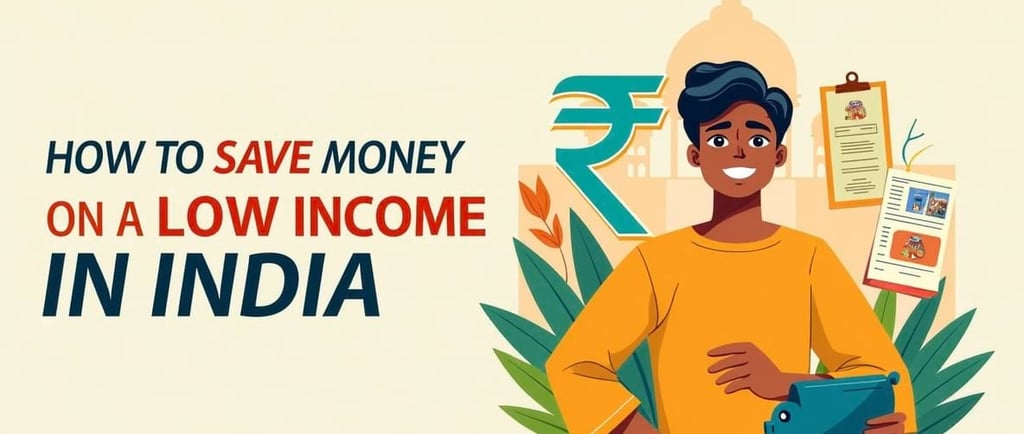How to Save Money on a Low Income in India
Struggling to save money on a tight budget? Discover 13 simple and practical ways to save money on a low income in India
Ayushi
8/2/20255 min read


Here's your blog with SEO-friendly headings based on your existing structure. I've kept the original wording intact, while converting each section into an appropriate H2 or H3 format that improves indexing and readability:
How to Save Money on a Low Income in India
Managing your finances on a low income can become an uphill battle, especially in a country like India where inflation, social pressures, and day-to-day living costs keep increasing. But the truth is this — saving money on a low income level is possible.
Here on this blog, we will dissect actionable, step-by-step advice that can be used to save money on a shoestring budget. You could be a student, working single, or breadwinner; these techniques can assist you in creating a stronger financial future.
Why Saving on a Low Income Matters
Before we proceed to strategies, let us know why one must save even if his/her income is meager:
To manage emergencies without resorting to borrowing.
In order to prevent credit card or payday loan debt traps.
To create a financial cushion for future investments (home, education, retirement, etc.).
To establish peace of mind and alleviate stress caused by money concerns.
Now, let's dive into how you can actually save on a shoestring budget.
1. Monitor Every Rupee You Spend
You can't save what you can't see. The majority of people spend money on little, unnoticed everyday expenses — snacks, unwanted subscriptions, rickshaw rides, online shopping, etc.
✅ How to do it:
Use an app such as Walnut, Monefy, or Money Manager to record all expenses.
Or mark it by hand in a notebook or Excel sheet.
Keep track of your weekly or monthly spendings and eliminate what is not needed.
Even ₹50 a day of tea/snack can amount to ₹1,500 a month. Awareness is the beginning of saving.
2. Formulate a Reasonable Monthly Budget
The second one after the tracking of your expenditure is budgeting.
✅ How to budget wisely:
Divide your income according to the 50-30-20 rule:
50% to pay expenses (rent, food, transportation)
30% for desires (ordering food, entertainment)
20% savings or debt repayment
If saving 20% is not possible, begin with 5% or 10%, but make it regular.
On ₹15,000 pay, saving ₹1,000 a month is like ₹12,000 a year.
3. Cut Down on Unnecessary Expenses
Reducing does not necessarily equate to living minimally. It means being financially prudent.
🔻 Here’s what you can reduce:
Shift to prepaid cellular plans — lower than postpaid.
Cancel out-of-home viewing services you don't watch regularly.
Resist impulse online buys — take it to cart for 24 hours first.
Prepare more meals at home rather than constant takeout.
Every little cut translates into substantial monthly savings.
4. Save First, Spend Later (Reverse Budgeting)
Most individuals save whatever is left after they spend. That never works.
✅ Instead:
Save some money the instant you are paid your salary.
Invest it in some other savings account or SIP.
Automate the transfer so that you don't miss.
This forces you to live within what’s left, and you build savings without even thinking.
5. Travel by Public Transport or Share Rides
Everyday travel can be a sneaky drain on your wallet.
🚗 Money-saving transport tips:
Take the metro, local trains, or bus wherever available.
Share taxi/cab trips with others.
Use apps like Ola Share, Rapido, Yulu for affordable travel.
Walk or bike short trips — it's healthy and free!
Saving ₹30–₹50 daily on travel means over ₹1,000/month.
6. Buy Groceries Smartly
Shopping for groceries is inevitable, but there are intelligent methods of saving.
🛒 Grocery saving tips:
Purchasing in bulk for non-perishables (atta, rice, dal) — it is more economical.
Buy from mandis or wholesalers in your area rather than malls.
Compare prices on BigBasket, Jiomart, Blinkit for offers.
Always buy off of a shopping list — never browse.
Also, do not go shopping when you're starving. You'll end up purchasing extra snacks!
7. Don't Take Loans for Minor Requirements
It is not difficult to borrow cash or use "Buy Now, Pay Later" schemes to buy things immediately, but they can get you into debt.
❌ Don’t:
Take payday loans
Buy excess EMI purchases
Use personal loans for festivals, travel, etc.
If necessary, borrow from relatives or friends interest-free — and only if you're certain you can pay back on time.
8. Save on Electricity and Water Bills
Utility bills are flat rates, but they can be cut down.
⚡ How to save on bills:
Use LED light bulbs — less power consumption.
Switch off fans/lights when leaving a room.
Repair dripping taps — each drip loses money.
Wash clothes in cold water and only in full loads.
One can save ₹300-₹500/month on electricity and water by making some changes.
9. Begin a Small Side Business
If your income cannot afford to save, augment it with extra work.
💼 Side hustle ideas:
Tutoring school children part-time
Freelance work (graphic designing, content writing, data entry)
Sale of tiffins or self-made snacks
Affiliate marketing through social media
An extra ₹2,000 a month can enhance your savings and reduce the burden.
10. Utilize Free Learning and Leisure Resources
Rather than paid courses or membership, use free alternatives.
🎓 Free alternatives:
Utilize Coursera and YouTube for free upskilling.
Watch free movies/series on MX Player, YouTube.
Read free PDF books, library books, or apps such as Storytel/Kindle trial.
Learning and living aren't always expensive — they cost only imagination.
11. Establish Financial Objectives
Having a goal gives you something to save for, or else it's a hassle.
🎯 Sample goals:
Save Rs. 5,000 for a smartphone upgrade
Save ₹20,000 as emergency fund within 1 year
Save Rs.50/day for future course
Break down your goal into smaller goals monthly and see how your passion grows.
12. Refrain from Peer Pressure and Social Expenditure
Wedding, birthday, festival, and gift expenditures in India are most often due to social pressure.
👥 Watch out:
Go to fewer events or provide homemade presents.
Don't purchase gold, fashion items, or electronics simply because others do.
Say "no" when you can't afford it — it's okay to put yourself first.
Financial independence begins when you begin not living based on other people's expectations.
13. Invest, Even If It's a Small Amount
After you've saved money, don't let it sit there — let it work.
💹 Where to begin:
SIP in mutual funds (at least ₹100/month)
Recurring Deposit (RD) from bank or post office
Sukanya Samriddhi Yojana (for girl child) or Digital gold
PPF account for long-term, tax-free savings
Little sums over a period of time compound to huge sums.
Conclusion: Every Rupee Counts
Frugality on a meager salary in India is not a question of being frugal — it's the question of being smart and attentive. Whether you make ₹10,000 or ₹15,000 a month, you can save if you are disciplined and regular.
Don't be discouraged if you are moving slowly. Just concentrate on developing good habits and not spending too much. Gradually, your small efforts will lay a strong platform for a safe financial future.
Key Takeaways
Account for and budget each rupee.
Eliminate wasteful spending.
Save first, then spend.
Use public transport and buy wisely.
Invest small, grow big.
✅ Let me know if you’d like a meta title + description, FAQ section, or internal linking suggestions to improve your SEO further.
About Company


